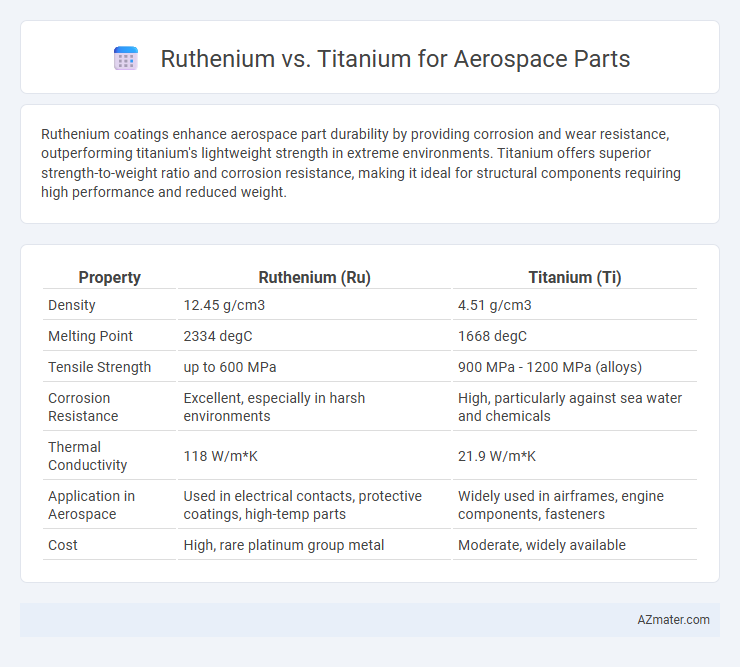Ruthenium coatings enhance aerospace part durability by providing corrosion and wear resistance, outperforming titanium's lightweight strength in extreme environments. Titanium offers superior strength-to-weight ratio and corrosion resistance, making it ideal for structural components requiring high performance and reduced weight.
Table of Comparison
| Property | Ruthenium (Ru) | Titanium (Ti) |
|---|---|---|
| Density | 12.45 g/cm3 | 4.51 g/cm3 |
| Melting Point | 2334 degC | 1668 degC |
| Tensile Strength | up to 600 MPa | 900 MPa - 1200 MPa (alloys) |
| Corrosion Resistance | Excellent, especially in harsh environments | High, particularly against sea water and chemicals |
| Thermal Conductivity | 118 W/m*K | 21.9 W/m*K |
| Application in Aerospace | Used in electrical contacts, protective coatings, high-temp parts | Widely used in airframes, engine components, fasteners |
| Cost | High, rare platinum group metal | Moderate, widely available |
Introduction: Ruthenium vs Titanium in Aerospace
Ruthenium and titanium offer distinct advantages for aerospace components, with ruthenium providing exceptional corrosion resistance and hardness, ideal for extreme environmental conditions. Titanium is favored for its high strength-to-weight ratio and excellent fatigue resistance, making it essential in lightweight structural parts. Both metals contribute to aerospace innovation by enhancing durability and performance under demanding operational stresses.
Material Composition and Properties
Ruthenium, a rare transition metal in the platinum group, offers exceptional hardness, corrosion resistance, and high-temperature stability, making it suitable for specialized aerospace components requiring durability under extreme conditions. Titanium, known for its lightweight nature, high strength-to-weight ratio, and excellent corrosion resistance due to its stable oxide layer, is widely used in aerospace structures to reduce weight while maintaining structural integrity. While titanium alloys dominate aerospace applications for structural parts, ruthenium is often used as coatings or in small alloying amounts to enhance wear resistance and oxidation resistance of critical engine parts.
Weight Considerations for Aerospace Applications
Ruthenium and titanium offer distinct advantages in aerospace applications, with titanium being favored for its excellent strength-to-weight ratio and low density of 4.51 g/cm3, contributing to significant weight savings in aircraft structures. Ruthenium, while heavier with a density of 12.45 g/cm3, provides superior corrosion resistance and high-temperature stability, making it suitable for specialized components exposed to extreme environments. Weight considerations prioritize titanium for primary load-bearing aerospace parts, whereas ruthenium is typically reserved for niche roles where durability outweighs mass constraints.
Strength and Durability Comparison
Ruthenium exhibits exceptional hardness and corrosion resistance, making it highly durable in extreme aerospace environments where wear resistance is critical. Titanium offers an excellent strength-to-weight ratio with superior fatigue resistance, making it ideal for structural aerospace components that require lightweight yet strong materials. Comparing both, ruthenium is favored for coatings and surface applications to enhance durability, while titanium is preferred for load-bearing parts due to its overall strength and lightweight properties.
Corrosion and Oxidation Resistance
Ruthenium exhibits superior corrosion and oxidation resistance compared to titanium, making it highly effective in harsh aerospace environments exposed to extreme temperatures and reactive chemicals. Titanium forms a protective oxide layer but can suffer from localized corrosion under aggressive conditions, whereas ruthenium maintains structural integrity due to its inert oxide formation. The enhanced durability of ruthenium alloys offers extended service life and reduced maintenance for critical aerospace components.
Thermal Stability and High-Temperature Performance
Ruthenium exhibits superior thermal stability and high-temperature performance compared to titanium, maintaining structural integrity at temperatures exceeding 1,500degC, making it ideal for aerospace components exposed to extreme heat. Titanium, while lightweight and corrosion-resistant, generally withstands maximum service temperatures around 600degC to 700degC, limiting its use in high-temperature aerospace applications. The exceptional oxidation resistance and melting point of ruthenium provide enhanced durability and longevity for critical parts such as turbine blades and heat shields in aerospace engineering.
Machinability and Fabrication Processes
Ruthenium exhibits superior wear resistance and hardness but poses significant challenges in machinability due to its brittleness and high melting point, making fabrication processes more complex and time-consuming. Titanium offers excellent machinability with favorable strength-to-weight ratio and corrosion resistance, facilitating easier fabrication through conventional methods such as CNC machining and additive manufacturing. For aerospace parts requiring intricate geometries and swift production cycles, titanium remains the preferred choice, while ruthenium's niche applications focus on wear-critical components benefiting from its hardness despite fabrication difficulties.
Cost Analysis and Availability
Ruthenium is significantly more expensive than titanium due to its rarity and complex extraction process, limiting its widespread use in aerospace components. Titanium offers a more cost-effective solution with excellent strength-to-weight ratio and corrosion resistance, making it the preferred choice for large-scale aerospace manufacturing. Availability of titanium is abundant globally, whereas ruthenium is scarce and primarily obtained as a byproduct of platinum mining, impacting its supply stability.
Common Aerospace Applications
Ruthenium's exceptional corrosion resistance and ability to enhance alloy hardness make it valuable for coatings and electrical contacts in aerospace applications, where durability under extreme conditions is critical. Titanium, known for its high strength-to-weight ratio and excellent fatigue resistance, is widely used in structural components such as airframe parts, engine components, and fasteners. While titanium serves as a primary material for load-bearing aerospace parts, ruthenium often functions as a surface treatment or alloying element to improve performance in specialized aerospace environments.
Future Trends and Material Innovations
Ruthenium's emerging role in aerospace parts centers on its exceptional corrosion resistance and high-temperature stability, critical for next-generation engine components and thermal barrier coatings. Titanium continues to dominate due to its superior strength-to-weight ratio and fatigue resistance, driving innovations in lightweight airframe structures and additive manufacturing techniques. Future trends suggest hybrid composites incorporating ruthenium-based coatings on titanium substrates, enhancing durability and performance in extreme aerospace environments.

Infographic: Ruthenium vs Titanium for Aerospace Part
 azmater.com
azmater.com